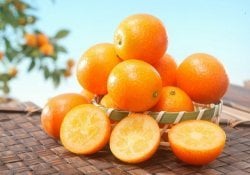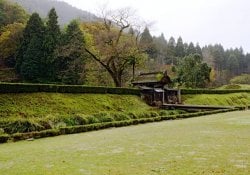Momotarō [桃太郎] is a character and popular story from Japanese folklore that tells the story of a boy who was born from a giant peach and adopted by a couple. The story continues with Momotaro traveling to the island of demons accompanied by a dog, a monkey and a pheasant.
The story may vary depending on the source consulted. It's basically a childish story told primarily in children's books with the aim of encouraging the punishment of good over evil with the iconic battle against demons.
In some versions of Momotaro an elderly couple rejuvenated after eating a peach and had him as their son. In both stories he fights to protect the villagers from the terrible oni carrying a mochi cake called kibidango capable of giving a thousand strengths.
Índice de Conteúdo
Momotaro's Story
Earlier I tried to summarize the story a bit, but let's get it right below:
Once upon a time, an old villager from Okayama who was washing clothes by the river as usual, found a giant peach and took it home with the intention of eating it with her husband. Surprised, they found a baby inside him and named him Momotaro.
The childless couple heard the child say, “Don't be afraid. I'm not a demon or a fairy. Heaven has heard your requests and sent me to be your son and take care of you in your old age.
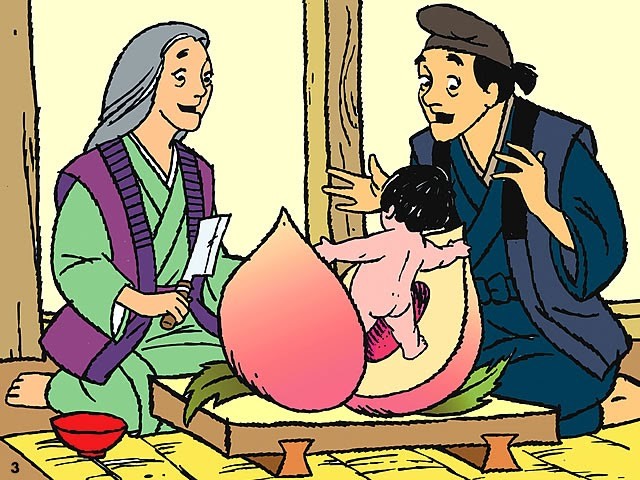
The old couple raised Momotaro to be big and strong. One day, he decided to leave the house to defeat the onis (demons) who lived in Onigashima. The oni were causing terror in the village, killing and looting the villagers.
Despite the sadness, the couple had confidence in Momotaro and supported his departure. For his trip he received several kibidango [黍団子], a type of dumpling made from mochiko (rice flour). Before leaving the elderly couple said: “Go with all care and speed. We hope that with the blessings of the gods, he returns soon and victorious!”.
On the way to his journey, a monkey, a dog and a pheasant joined him, promising to help him against the oni in exchange for kibidango dumplings. Upon arriving at the Island, they discover that the gate of the fort where the oni were is locked.
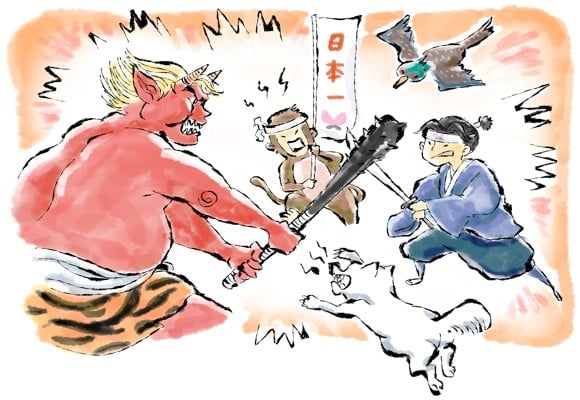
The pheasant flew into the fort and took the key to open the gate. Once inside, they fought the onis. The pheasant pecked its eyes, the dog bit its legs, and the monkey jumped on the demons' backs. In the end, the Devils cried for mercy! In order for their lives to be spared, they gave Momotaro all the stolen treasure.
Momotaro and his companions returned to the village and were greeted with a great party, being declared a hero by his people. The treasure was shared among all the villagers and their old parents were able to live comfortably until the end of their days.
The importance of Momotaro
Despite being a simple story within so many Japanese stories, its purpose is to serve as a model for children since its origin in the Meiji Era. The story highlights bravery, power and parenting.
It is believed that in the original version Momotaro born by natural childbirth after the elderly couple rejuvenated themselves by eating a peach, it looks quite different, but in order not to confuse children the giant peach version was adopted.
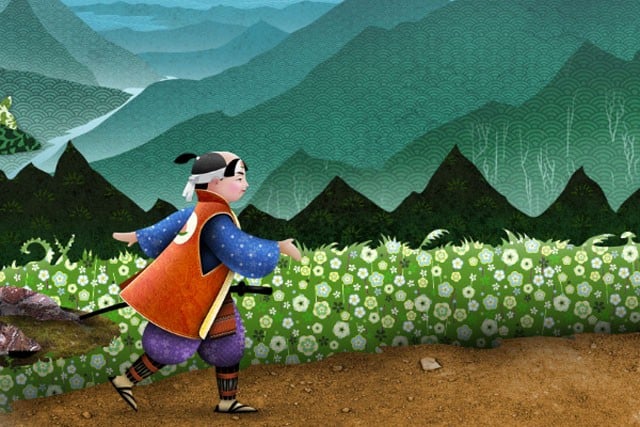
What is the origin of Momotaro?
There are several theories about the origin of the stories based on the legend of Momotaro, and each of them is controversial. Some claim that the story may have originated in another prefecture such as Aichi and Kagawa, but that it became popular in Okayama due to its promotion in 1960. after the war.
The exact date of its formation as a story is unknown, but the origin of the prototype (literature) is said to be from the end of the Muromachi period to the beginning of the Edo period. Since then, it has become widespread through publications such as the red book.
In Edo period literature, the treasures Momotaro brings back are swords, caps, hammer, gold, silver, and life-extending bags. In the other stories gold and sango jewelry are added.
The Momotaro legend closely resembles the Okinawan legend of a princess named Urikohime [瓜子姫] that is born from a melon. Others have found similarities to the Indian legend of Ramayana.
There are theories that both Japanese legends came from similar legends of people appearing from inside things. Some claim that the Oni island gate references Fengshui beliefs.
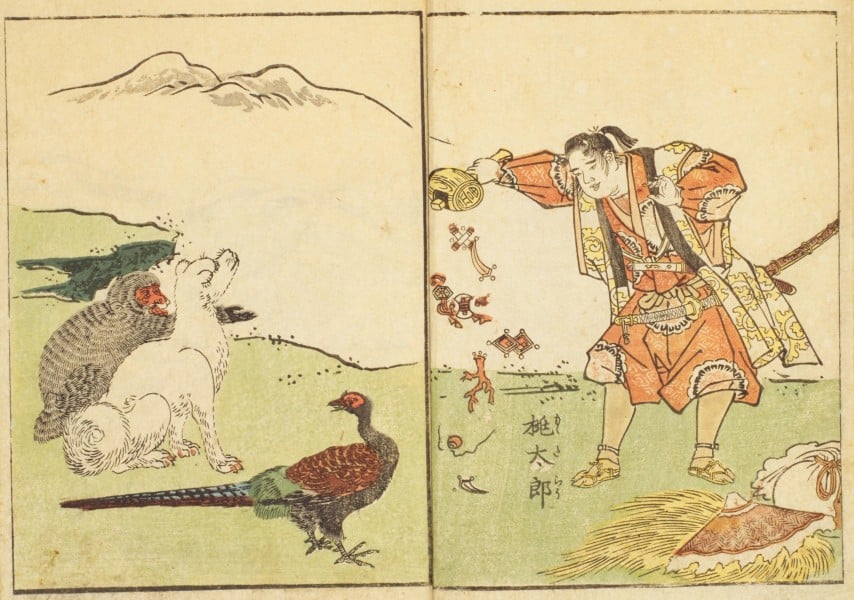
The article is still halfway through, but we recommend also reading:
Japanese version of the Momotaro Legend
Below is a popular version of the Japanese Legend of Momotaro:
むかしむかしの おはなしです。
おばあさんが かわで せんたくをしていると…
どんぶらこっこ どんぶらこっこ。
「おやまあ、おおきな ももが ながれてきたよ」
いえに もってかえると、
ぱかっ!
「おんぎゃあー!」
なかから おとこのこが うまれました。
「げんきなこだねえ」
おばあさんが にこにこすると、
「ももからうまれた ももたろうだね」
おじいさんも うれしそうに いいました。
ももたろうは もりもり ごはんをたべて
ぐんぐん おおきくなりました。
あるひ むらの たからものが おにに ぬすまれてしまいました。
つよくて やさしい ももたろうは
「ぼくが とりかえしてくるよ!」
そういって、おにがしまへ いくことにしました。
「ももたろう、これを もっておいき」
おばあさんが おいしい きびだんごを
つくってくれました。
「きびだんご ひとつ くださいわん」
「うん、いいよ」
いぬが ももたろうに ついてきました。
「きびだんご ひとつ くださいうきー」
「うん、いいよ」
さるも ももたろうに ついてきました。
「きびだんご ひとつ くださいっぴー」
「うん、いいよ」
きじも ももたろうに ついてきました。
とうとう おにがしまに つきました。
「こらー、おにたち。たからものを かえすんだ!」
「かえすわん!」
「かえすうきー!」
「かえすっぴー!」
みんなで おおきなこえを だしました。
「かえせー!」
「わんわん!」
「うきーうきー!」
「ぴーぴー!」
あまりにもうるさいので、おには みみがいたくて かないません。
「やめてくれー、たからものは かえすから」
「もう わるいことを してはいけないよ」
「ごめんなさい、もうしません」
おには やくそくしました。
ももたろうは たからものをもって
むらに かえりました。
「おかえり、ももたろう」
「ありがとう、ももたろう!」
おじいさんも おばあさんも むらのみんなも とてもよろこびました。
The Songs of Momotaro
There is a song by Momotaro written by the Ministry of Education that first appeared in Ordinary Elementary School Song in 1911 composed by Sadaichi Okano. See the lyrics in Japanese below:
- 桃太郎さん、桃太郎さん、お腰につけた黍団子、一つわたしに下さいな。
- やりましょう、やりましょう、これから鬼の征伐に、ついて行くならやりましょう。
- 行きましょう、行きましょう、貴方について何処までも、家来になって行きましょう。
- そりや進め、そりや進め、一度に攻めて攻めやぶり、つぶしてしまへ、鬼が島。
- おもしろい、おもしろい、のこらず鬼を攻めふせて、分捕物をえんやらや。
- 万万歳、万万歳、お伴の犬や猿雉子は、勇んで車をえんやらや。



